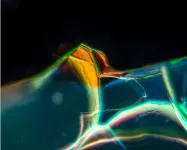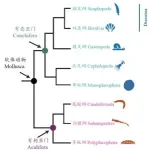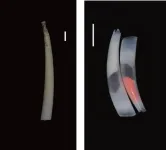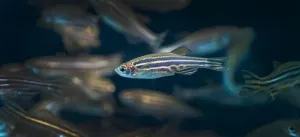(Press-News.org) Some 2,000 years ago in ancient Rome, glass vessels carrying wine or water, or perhaps an exotic perfumes, tumble from a table in a marketplace, and shatter to pieces on the street. As centuries passed, the fragments were covered by layers of dust and soil and exposed to a continuous cycle of changes in temperature, moisture, and surrounding minerals.
Now these tiny pieces of glass are being uncovered from construction sites and archaeological digs and reveal themselves to be something extraordinary. On their surface is a mosaic of iridescent colors of blue, green and orange, with some displaying shimmering gold-colored mirrors.
These beautiful glass artifacts are often set in jewelry as pendants or earrings, while larger, more complete objects are displayed in museums.
For Fiorenzo Omenetto and Giulia Guidetti, professors of engineering at the Tufts University Silklab and experts in materials science, what’s fascinating is how the molecules in the glass rearranged and recombined with minerals over thousands of years to form what are called photonic crystals – ordered arrangements of atoms that filter and reflect light in very specific ways.
Photonic crystals have many applications in modern technology. They can be used to create waveguides, optical switches and other devices for very fast optical communications in computers and over the internet. Since they can be engineered to block certain wavelengths of light while allowing others to pass, they are used in filters, lasers, mirrors, and anti-reflection (stealth) devices.
In a recent study published in the Proceedings of the National Academy of Sciences (PNAS) USA, Omenetto, Guidetti and collaborators report on the unique atomic and mineral structures that built up from the glass’ original silicate and mineral constituents, modulated by the pH of the surrounding environment, and the fluctuating levels of groundwater in the soil.
The project started by chance during a visit to the Italian Institute of Technology’s (IIT) Center for Cultural Heritage Technology. “This beautiful sparkling piece of glass on the shelf attracted our attention,” said Omenetto. “It was a fragment of Roman glass recovered near the ancient city of Aquileia Italy.” Arianna Traviglia, director of the Center, said her team referred to it affectionately as the ‘wow glass’. They decided to take a closer look.
The researchers soon realized that what they were looking at was nanofabrication of photonic crystals by nature. “It's really remarkable that you have glass that is sitting in the mud for two millennia and you end up with something that is a textbook example of a nanophotonic component,” said Omenetto.
Corrosion and Reconstruction
Chemical analysis from the IIT team dated the glass fragment to between the 1st century BCE and the 1st century CE, with origins from the sands of Egypt – an indication of global trade at the time. The bulk of the fragment preserved its original dark green color, but on its surface was a millimeter-thick patina that had an almost perfect mirror-like gold reflection. Omenetto and Guidetti used a new kind of scanning electron microscope that not only reveals the structure of the material, but also provides an elemental analysis. “Basically it's an instrument that can tell you with high resolution what the material is made of and how the elements are put together,” said Guidetti.
They could see that the patina possessed a hierarchical structure made up of highly regular, micrometer-thick silica layers of alternating high and low density which resembled reflectors known as Bragg stacks. Each Bragg stack strongly reflected different, relatively narrow wavelengths of light. The vertical stacking of tens of Bragg stacks resulted in the golden mirror appearance of the patina.
How did this structure form over time? The researchers suggest a possible mechanism that played out patiently over centuries. “This is likely a process of corrosion and reconstruction,” said Guidetti. “The surrounding clay and rain determined the diffusion of minerals and a cyclical corrosion of the silica in the glass. At the same time, assembly of 100 nanometer-thick layers combining the silica and minerals also occurred in cycles. The result is an incredibly ordered arrangement of hundreds of layers of crystalline material.”
“While the age of the glass may be part of its charm, in this case if we could significantly accelerate the process in the laboratory we might find a way to grow optic materials rather than manufacture them,” Omenetto added.
The molecular process of decay and reconstruction has some parallels to the city of Rome itself. The ancient Romans had a penchant for creating long-lasting structures like aqueducts, roads, amphitheaters, and temples. Many of these structures became the foundation of the city's topography.
Over the centuries since, the city has grown in layers, with buildings rising and falling with the changes brought on by wars, social upheavals and the passage of time. In medieval times, people used materials from broken and abandoned ancient buildings for new construction. In modern times, streets and buildings are often built directly on top of ancient foundations.
“The crystals grown on the surface of the glass are also a reflection of the changes in conditions that occurred in the ground as the city evolved – a record of its environmental history,” said Guidetti.
END
Buried ancient Roman glass formed substance with modern applications
Researchers reveal how photonic crystals were created by corrosion and crystallization over centuries
2023-09-18
ELSE PRESS RELEASES FROM THIS DATE:
Genomes of enigmatic tusk shells provide new insights into early Molluscan evolution
2023-09-18
Accurate phylogenetic trees are fundamental to evolutionary and comparative biology, but the almost simultaneous emergence of major animal phyla and diverse body plans during the Cambrian Explosion poses major challenges to reconstructing deep metazoan phylogenetic relationships.
This is particularly true for the second largest phylum, Mollusca, whose major lineages originated in the Cambrian period. The diverse fossil record, extreme morphological disparity among the eight living classes, and dramatic conflict among phylogenetic hypotheses due to diverse paleontological, ...
Remote work can slash your carbon footprint — if done right
2023-09-18
ITHACA, N.Y. – Remote workers can have a 54% lower carbon footprint compared with onsite workers, according to a new study by Cornell University and Microsoft, with lifestyle choices and work arrangements playing an essential role in determining the environmental benefits of remote and hybrid work.
The study, published in the Proceedings of the National Academy of Sciences, also finds that hybrid workers who work from home two to four days per week can reduce their carbon footprint by 11% to 29%, but working from home one day per week ...
Preschoolers from low-income families may have worse health and benefit less from health promotion interventions than children with higher socioeconomic status
2023-09-18
Low socioeconomic status can negatively impact children’s health in preschool, along with their ability to follow specialized health education intervention programs, Mount Sinai researchers found in an international study focused on health promotion in schools, including those in the Harlem section of New York City. The results, published September 18 in the Journal of American College of Cardiology, stress the importance of introducing a specialized health curriculum in classrooms starting in preschool.
“This study shows that socioeconomic factors, including lower household income and education level, can negatively impact children’s health starting ...
Oregon State receives $7.5 million grant to build state of the art zebrafish biomedical research facility
2023-09-18
CORVALLIS, Ore. – Oregon State University has received a $7.5 million National Institutes of Health grant to modernize a lab focused on using zebrafish to address pressing human health challenges.
The Sinnhuber Aquatic Research Laboratory, led by Distinguished Professor Robyn Tanguay, a molecular toxicologist in the College of Agricultural Sciences, exploits the unique advantages of zebrafish to protect and improve human and environmental health. Zebrafish and humans have similar developmental processes and are similar on a genomic level, ...
Employee surveys may miss out on uncovering toxic leadership practices
2023-09-18
BINGHAMTON, N.Y. -- Standardized and overly simplistic questionnaires are only scratching the surface of what employees think of their leaders, according to new research from Binghamton University’s School of Management (SOM), and negative behavior may be slipping through the cracks.
As a result, the research finds, organizations may be missing out on critical information that could be keeping toxic leaders in positions of power.
“Instead of capturing actual leader behaviors, ratings might simply reflect whether a person likes their leader,” said Mengying ...
Key to solving Libyan conflict lies within the country, analysis says
2023-09-18
The key to solving the Libyan political conflict lies within the country rather than with the international community, analysis says.
Electoral and governance deadlock has been blamed for the devastating impact of the flooding in the country.
The “contentment” of the political elite and others with the status quo - given the currently limited levels of violence and the rising global prices of energy since the outbreak of Russia’s war on Ukraine - explains the general lack of a genuine commitment to relaunch the transition and electoral roadmap, ...
Personalized combination treatment turns on an immunometabolic switch to effectively control an aggressive form of prostate cancer
2023-09-18
Researchers at the University of Chicago Medicine Comprehensive Cancer Center established “proof-of-concept” for a new treatment approach that was able to effectively treat the most aggressive forms of prostate cancer. The treatment showed complete tumor control and long-lasting survival without side effects in a mouse model of advanced prostate cancer.
These findings, which were published online September 18, 2023, in Clinical Cancer Research, warrant further investigation in human clinical trials, the researchers concluded.
Strategies to overcome resistance
“Prostate cancer in the metastatic ...
Power meals: Child care-provided meals are associated with improved child and family health
2023-09-18
Philadelphia, September 18, 2023 – Very young children who attend child care and receive onsite meals and snacks were more likely to be food secure and in good health, and less likely to be admitted after a hospital emergency department visit than children in child care whose meals and snacks were provided from home, according to a new study in the Journal of the Academy of Nutrition and Dietetics, published by Elsevier. These potential benefits could extend beyond the children themselves to their families, including through possible reductions in stress, and to society as a whole through potentially significant healthcare cost savings.
Lead author Stephanie ...
DOE backs Rice study of how soils store carbon
2023-09-18
HOUSTON – (Sept. 18, 2023) – Two Rice University scientists have received a 3-year grant from the Department of Energy (DOE) to investigate a form of carbon storage that is as little understood as it is ubiquitous: soil.
Mark Torres, an assistant professor of Earth, environmental and planetary sciences, and Evan Ramos, a postdoctoral fellow in the Torres lab, will track how key minerals form in a watershed to build a fuller picture of the processes that allow soil to store carbon as organic matter.
“Soil on Earth contains three times more carbon than the atmosphere,” Ramos said. “We ...
University of Colorado Anschutz Medical Campus receives $54 million from NIH
2023-09-18
The National Institutes of Health has awarded $54 million over a seven-year period to the CCTSI at CU Anschutz. The grant from the National Center for Advancing Translational Sciences (NCATS) will fuel biomedical research and training across the state. This is the fourth consecutive time the NIH has funded the CCTSI since 2008 through its Clinical Translational Science Award (CTSA) program.
“This powerful grant will allow the University of Colorado to conduct leading-edge research that can directly impact health and patient care, reduce health disparities across our state and remain poised to respond to public ...
LAST 30 PRESS RELEASES:
Why nail-biting, procrastination and other self-sabotaging behaviors are rooted in survival instincts
Regional variations in mechanical properties of porcine leptomeninges
Artificial empathy in therapy and healthcare: advancements in interpersonal interaction technologies
Why some brains switch gears more efficiently than others
UVA’s Jundong Li wins ICDM’S 2025 Tao Li Award for data mining, machine learning
UVA’s low-power, high-performance computer power player Mircea Stan earns National Academy of Inventors fellowship
Not playing by the rules: USU researcher explores filamentous algae dynamics in rivers
Do our body clocks influence our risk of dementia?
Anthropologists offer new evidence of bipedalism in long-debated fossil discovery
Safer receipt paper from wood
Dosage-sensitive genes suggest no whole-genome duplications in ancestral angiosperm
First ancient human herpesvirus genomes document their deep history with humans
Why Some Bacteria Survive Antibiotics and How to Stop Them - New study reveals that bacteria can survive antibiotic treatment through two fundamentally different “shutdown modes”
UCLA study links scar healing to dangerous placenta condition
CHANGE-seq-BE finds off-target changes in the genome from base editors
The Journal of Nuclear Medicine Ahead-of-Print Tip Sheet: January 2, 2026
Delayed or absent first dose of measles, mumps, and rubella vaccination
Trends in US preterm birth rates by household income and race and ethnicity
Study identifies potential biomarker linked to progression and brain inflammation in multiple sclerosis
Many mothers in Norway do not show up for postnatal check-ups
Researchers want to find out why quick clay is so unstable
Superradiant spins show teamwork at the quantum scale
Cleveland Clinic Research links tumor bacteria to immunotherapy resistance in head and neck cancer
First Editorial of 2026: Resisting AI slop
Joint ground- and space-based observations reveal Saturn-mass rogue planet
Inheritable genetic variant offers protection against blood cancer risk and progression
Pigs settled Pacific islands alongside early human voyagers
A Coral reef’s daily pulse reshapes microbes in surrounding waters
EAST Tokamak experiments exceed plasma density limit, offering new approach to fusion ignition
Groundbreaking discovery reveals Africa’s oldest cremation pyre and complex ritual practices
[Press-News.org] Buried ancient Roman glass formed substance with modern applicationsResearchers reveal how photonic crystals were created by corrosion and crystallization over centuries







